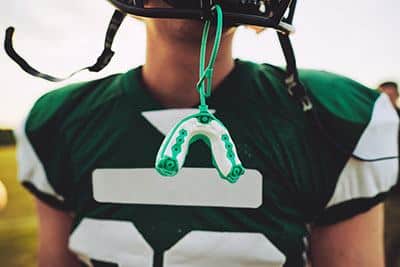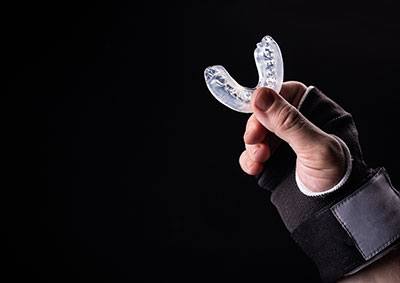Are you a lacrosse player getting ready for another great season? If so, chances are that you're also preparing your equipment - helmets, sticks, and pads being some of the necessities.
Protecting yourself in any sport is essential, and one of the most important pieces of safety gear is a mouthguard! But how do you put a mouthguard on a lacrosse helmet correctly?
Please read our blog post to learn the best procedure for lacrosse players when putting on their mouthguards for maximum protection.
More...
Take Away Key Points:
Attaching the mouth guards to lacrosse helmets: What you must know
If you need to learn how to attach a mouthguard to your lacrosse helmet for extra protection, thoroughly read the steps below. You will find the best practices to provide the best fitting and prevent injuries. Let's start!
Are mouth guards necessary in men's and women's lacrosse?
Lacrosse mouthguards are undoubtedly an essential piece of lacrosse equipment for both men's and women's lacrosse. Mouthguards provide protection for the teeth, face, and jaw from otherwise potentially damaging blows during gameplay.
Furthermore, in the event of a collision between two players or with the ground, mouthguards protect against concussions and other head-related injuries by helping absorb impacts and even spread them out across a larger surface area.
Therefore, not wearing mouthguards during lacrosse games can be considered a risky decision if protection for your head and face is an important factor to you!

What's the main purpose of lacrosse mouth guards?
Wearing mouth guards has become increasingly popular in lacrosse, as protection against potentially serious dental injuries is a top priority for athletes of all genders.
Mouthguards can be customized with sizes and colors to match each athlete's aesthetic preferences, making them more inviting than ever.
While dental injury prevention is highly recommended, and it is one important benefit of wearing a mouth guard, several other advantages should be considered before you start playing lacrosse.
Perhaps most importantly, mouthguards mitigate the chance of concussion by providing much-needed protection to the temporal mandibular joint.
Furthermore, a mouth guard can also reduce jaw tension, allowing players to stay focused and energized while engaging in intense physical contact.
As such, both boys and girls must consider wearing a custom-fit mouth guard when playing sports of lacrosse to maximize protection from injury and remain at peak performance on the field.
Can you play lacrosse without mouthguards?
Playing lacrosse without a mouthguard is never recommended, especially for boys and girls. Instead, every player should protect their teeth, mouth, and face as much as possible.
Not only is it essential to use a mouth guard to decrease the chances of serious dental or facial injuries, but it can also help with breathing in the middle of a game, which is critical to maintaining the stamina required to play lacrosse.
Although some people may think they are saving time and money by not wearing a mouthguard, it's important to remember that protecting yourself and others during sports games is fundamental for everyone's well-being.
The same rule applies to box lacrosse. Box lacrosse players must also wear mouthguards attached to their helmets to prevent facial and head injuries.
The mouthguard will prevent all players from concussions and other injuries, as playing box lacrosse uses more aggressiveness and strength than field lacrosse for boys and girls. So, the players must attach the mouthguard to the lacrosse helmet correctly to ensure an excellent grip and fitting of the gear.
How to attach the mouthguard to the lacrosse helmet properly?
Follow the steps below to ensure the correct attaching:
Step 1: Attaching the straps to the helmet
Attaching a guard to your helmet is simple. If your helmet has a cage, just fit the guard close to the chin pad. This ensures that it won't obstruct your vision in any way.
Step 2: Securing the straps
Secure the guard's straps through the holes in the bar of the cage.
Step 3: Check the security of the mouthguard
Wear your helmet and position the guard in your mouth. Pull the strap to secure the guard firmly against your mouth.
Step 4: Testing the comfort of the mouthguard
Be sure the mouth guard rests comfortably and firmly in your mouth. To check if it's secure, tug on the strap.
If the mouthguard comes out of your mouth, give the strap a stronger pull until it stays in place. Then, test it to make sure you've got the right fit for protection.
Checking if the mouthguard attached to the lacrosse helmets fits properly
Wearing a mouthguard is primarily to protect you from harm. Failing to fit it properly could still leave you vulnerable to injury. However, the good news is that you can check its fit before participating in any activity. This includes:
1. No gagging
The mouthguard should not make you gag; if it does, you haven't fitted it correctly. This usually happens when the guard is too large and covers all your upper teeth, but this isn't necessary - the guard just needs to cover up to the first molar to offer protection.
Going beyond this point can be uncomfortable and provide no extra protection. Additionally, if the guard goes beyond the first molar, it can make it hard for you to open or close your mouth, leading to the feeling of gagging as you struggle to keep it in place with your teeth.
2. No need to clench or bite

If you have to bite or clench your teeth to keep your mouthguard in place, it's a sign that it needs to be adjusted. A properly fitted guard should remain secure without requiring additional effort. Thus, the guard will allow you to concentrate on the game without being distracted by your mouthguard.
Best mouthguards for all lacrosse players
Lacrosse is a fast-paced, physical sport that requires protection for the players from a hard lacrosse ball.
A lacrosse mouthguard is an essential piece of equipment to protect your teeth and mouth from injury. Many different types of lacrosse mouthguards are on the market, but some stand out above the rest.
The SISU Aero Super-Slim Custom Fit Lacrosse Mouthguard for the helmet is a top pick for its thin profile and superior comfort. The mouthguards offer a custom fit that molds to your teeth for maximum protection without compromising breathability or speech.
The Gladiator Mouthguard for the helmet also provides excellent protection with its triple-layer design and shock-absorbing technology.
For those who wear braces, the Shock Doctor Double Braces Mouthguard is an ideal choice. The Shock Doctor mouthguards have an integrated ortho channel that fits securely over brackets and bands while providing superior protection against impacts. Finally, the Shock Doctor mouthguards for the helmet are the most popular game equipment to purchase.
The Beast Gear Children's Customized Lacrosse Mouthguard is another excellent face mask for kids and their lacrosse helmets, as it comes in fun colors and can be customized with their name or team logo.
No matter what type of lacrosse mouthguard you choose, make sure it fits properly and offers adequate protection for your needs and purchase. With the right mouthguard, you can play or practice the game confidently, knowing you're protected from any potential injuries!
Summary
Wearing a lacrosse mouth guard is not only crucial for protecting players from facial and head injuries, but it also provides increased safety standards while on the field.
Therefore, all players must wear the guards, with no exceptions. This rule ensures that all players are protected from potential injuries and can play safely without worry.
